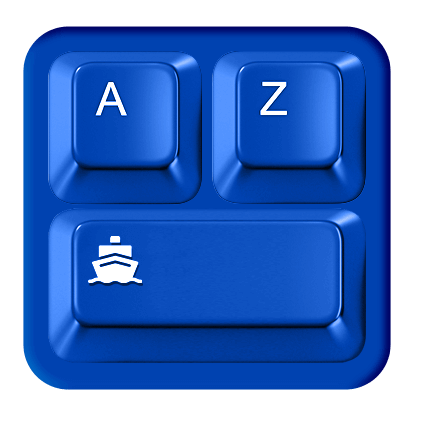| Term | Definition |
| IALA | The International Association of Lighthouse Authorities (IALA) is an international non-profit organization promoting safe, effective, and efficient navigation and aid navigation systems. IALA’s membership includes over 140 maritime administrations, lighthouse authorities, port authorities, and other organizations from over 80 countries. IALA’s work is organized into four main areas including Navigation aids, Communications, Training and education, and Technical assistance. |
| Identification System | The Identification System is the standard used worldwide to communicate between vessels on the sea/ocean. Data is electronically transmitted using this technique between a ship and the AIS receiving station. Data can be sent from one ship to another, from a ship to a station on land, or from a ship to a satellite. Additionally, all vessels near one another and having AIS integration can see each other’s course and speed. |
| Import | The import process refers to receiving or bringing goods from a foreign country for trade. Individuals, companies, or governments can do this, and the imported goods are used for further processing or resold to final consumers. |
| Import Duties | Import duties are taxes that are imposed on imported goods. The purpose of import duties is to protect businesses and industries in the country from foreign competition. Import duties are also used to generate revenue for the government. |
| Importer | An importer is a person or business that purchases products from another country for sale in their own country. The importer is responsible for ensuring that the products they are importing comply with all applicable laws and regulations in their country of import. |
| In-house Transport | In-house transport refers to transporting goods or materials within the same organization or company. This can include the movement of goods between different departments or locations within the same building or between different buildings owned by the same organization. In-house transport can be carried out using various methods, including manual labor, conveyor belts, forklifts, and cranes. |
| In-plant Logistics | In-plant logistics manages the movement of goods and materials within a manufacturing or distribution facility. This includes coordinating receiving, storage, production, and shipping activities. In-plant logistics also encompasses the management of information and materials flow between the various departments within a facility. |
| Inbound Logistics | Inbound logistics manages the receipt and storage of raw materials used in manufacturing. This includes coordinating and transporting suppliers’ deliveries to the production facility. |
| Incoterms | The International Commercial Terms (Incoterms) are lists of pre-defined commercial terms established by the International Chamber of Commerce (ICC) and frequently used in international commercial transactions. |
| Industry 4.0 | Industry 4.0 is the current automation and data exchange trend in manufacturing technologies. It includes cyber-physical systems, the Internet of Things, cloud computing, and cognitive computing. |
| Instruments of Order Processing | The instruments of order processing are the tools and methods used to track and manage customer orders. These can include software systems, manual processes, or a combination. Order processing typically includes Order entry, Order confirmation, Order fulfillment, Order tracking, and Order closure. |
| Insurance Certificate | An insurance certificate is a document that proves that a person or business has insurance coverage. The certificate includes the insurance company’s name, policy number, type and amount of coverage, and policy dates. |
| Integrated Logistics | Integrated logistics is a supply chain management approach that considers all aspects of a company’s operations, including design, production, delivery, and customer service. The goal of integrated logistics is to optimize the entire supply chain, from raw materials to finished products, to improve efficiency and minimize costs. |
| Interface (API) | An interface is an API that allows two pieces of software to communicate with each other. This interface is used for data processing or data exchange. |
| Intermediate Bulk Container (IBC) | An intermediate bulk container (IBC) is a reusable container made for storing and transporting bulk liquids. IBCs are built to be sturdy and lightweight, and they come in a variety of shapes and sizes. IBCs often store and transport chemicals, food, and other liquids. |
| Intermodal | Intermodal transportation is the movement of containerized freight using multiple modes of transportation, such as planes, trains, automobiles, and boats. |
| Internal Loader | A semi-trailer with an internal loading mechanism is known as an internal loader and can be used to load and unload freight without using a separate loading dock or crane. The internal loading system typically consists of a conveyor belt that runs the length of the trailer, which can be used to load or unload cargo. The internal loading system can also load or unload other types of trailers, such as flatbed trailers. |
| International Air Transport Association (IATA) | The International Air Transport Group (IATA) represents 290 airlines and 84% of global air travel and is the airline trade association. IATA aids in the development of industry standards and policies and promotes airline activities. Additionally, it offers services in various fields, such as efficiency, security, and protection of the environment. |
| International Transportation | International transportation is the process of shipping goods from one country to another. This can be done by air, land, or sea and often involves multiple forms of transportation to get the cargo to its final destination. |
| Intralogistics | Intralogistics refers to planning, implementing, executing, and controlling all internal material flows in a business. Intralogistics is the word used to describe all material and product flows on a company’s premises. |
| Intrastat Commodity Codes | Intrastat commodity codes are eight-digit codes used to classify goods for statistical purposes. The first two digits of the code indicate the product’s chapter in the Harmonized System (HS) of product classification. The remaining six digits are further breakdowns of the product within that chapter. Intrastat commodity codes are used to track the movement of goods between countries in the European Union (EU). They are also used to compile trade flows statistics and monitor compliance with EU trade regulations. |
| Inventory | Inventory is a collection of items that are either used to produce a product or are used to produce a product. The purpose of the inventory is to ensure that a company has enough raw materials and finished products to meet customer demand. Inventory plays a significant role when a company’s assets are listed on its balance sheet at the conclusion of each fiscal year. |
| Inventory Control | Inventory control is a system used to track inventory levels, orders, sales, and deliveries. It is also used to manage stock levels and ensure that products are available when needed. |
| Inventory Cost | Inventory cost is the cost of goods that a company has in stock. This can include the cost of materials, labor, and other expenses associated with keeping the inventory on hand. |
| Inventory Management | Inventory management is the process of monitoring and controlling orders, stock, and inventory levels to make sure that firms have enough inventory on hand to satisfy client demand. |
| Inventory Optimization | Inventory Optimization is ensuring that a company has the right inventory level to meet customer demand while minimizing the costs associated with holding inventory. This can involve several activities, such as forecasting and demand planning tools to predict future customer demand, setting inventory targets, and implementing inventory management processes. |
| Inventory Security | Inventory security is the protection of a company’s inventory from loss or theft. This can be done through a variety of methods, such as security cameras, alarms, and guards. |
| Inventory Turnover Rate | The inventory turnover rate measures how quickly a company sells its inventory. The company’s capital is utilized more efficiently and needs less capital when the inventory turnover rate is higher. |
| Invoice | An invoice is a document a company sends to its customers to request payment for goods or services. An invoice may be created in paper or electronic form, and It typically includes the following information: the name and contact information of the company, the customer’s name and contact information, a description of the goods or services sold, the date of the sale, the amount due, the payment terms, and the date by which payment is due. |
All shipments in one place
We are with you until the end






